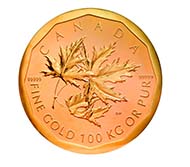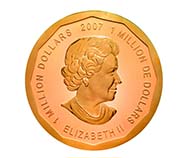by courtesy of the Berlin Coin Cabinet
on the occasion of its exhibit “Gold Giants”
The preliminary highlight of the production of extraordinarily big gold coins is this Maple Leaf of the Royal Canadian Mint. The Canadian Mint sells the Maple Leafs, named after the motive on the reverse, as regular bullion coins since September 1979 and since 1982 with a fineness of 999.9/1000.
1100 kilograms – Canada, $1,000,000 CAD, Maple Leaf, 2007, Royal Canadian Mint, Ottawa. Gold, 100 kg. 530 mm, thickness 30 mm. Boris Fuchsmann.
In celebration of the edition of new Maple Leafs (troy ounces) with the new and highest, hitherto unparalleled, fineness of 999.99/1000 the Ottawa Mint crafted a special example weighing 100 kilograms (= 3,215 troy ounces) of the same fineness with the face value of $1 million.
Originally designed as a unique showpiece, the report on the planned production already aroused such great an interest with inverstors that five examples of this literal gold giant were produced in 2007. One remained with the manufacturer and the other four were sold to investors. On May 3rd, 2007, the Maple Leaf of 100 kg was presented to the press, in conjunction with its finest siblings. A few months later, on October 18th, 2007, the Royal Canadian Mint proudly announced that the Guiness World Records officially recognized this coin to be the largest gold coin of the world. Canada, therefore, has managed to set several benchmarks: whereas gold bars with a fineness of 999.9/1000 were produced since 1969 and corresponding coins since 1982, the threshold of 999.99/1000 with bullion coins was reached in 1999. Finally, in 2007, the first troy ounce coins »Maple Leaf« and this monumental representative of the same type with a five-figure 9 was issued. This means that of one million parts only ten are not gold.
The overcoming of technical problems accompanying the production of this coin with its thickness of 3 cm and its diameter of 53 cm is a formidable achievement in itself. Using special equipment for keeping the temperature of the liquid gold constant, the coin was cast in one piece and engraved in another working step. The obverse with the portrait of Elizabeth II was created after the design of the Canadian artist Susanna Blunt. The reverse was made by Stan Witten, senior engraver of the Canadian Mint. The official face value of $1 million for this giant looks rather modest. In June this year, this example was auctioned off in Vienna for €3.5 million. At present, the gold value accounts for €3.1 million (as of October 7th, 2010). It may be a comfort to collectors and investors alike that the small fine siblings of this giant, likewise carrying a tag with five 9s on it, are available for considerably less money. It takes about 3,215 of these troy ounces to balance this giant.
This gold giant can be viewed in the exhibit of the Berlin Coin Cabinet bearing the same title. For more information click here. Unfortunately, the preview of the exhibit is available in German only.





